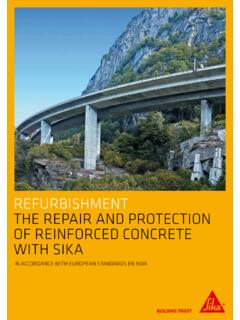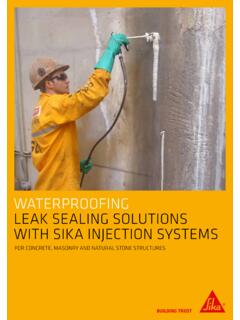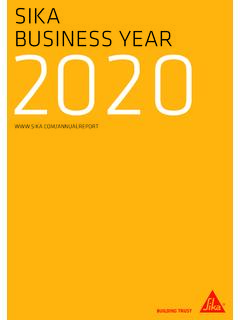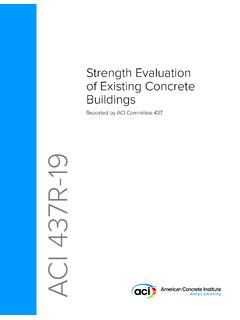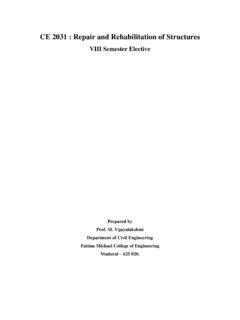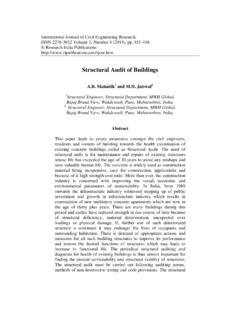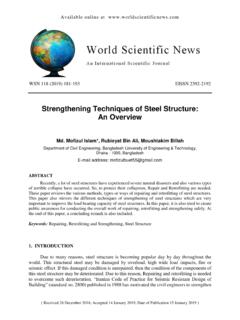Transcription of Protective Coatings for Concrete
1 REFURBISHMENTPROTECTIVE Coatings FOR CONCRETE2 REFURBISHMENTPROTECTIVE Coatings FOR CONCRETEC oncrete is a material especially used in civil engineering structures for its strength and durability. For buildings it also has to achieve the look and beauty envisaged by the owner and their architect. To enhance these aesthetics and bring more colors, or for example to increase the durability of the Concrete by preventing water ingress and to seal and accommodate surface cracks, Protective coating systems can provide the ideal have developed and produced coating systems that are used all around the world to protect Concrete surfaces and structures for many decades. This includes the protection of all types of buildings and structures, in various types of environment and climatic conditions, from the winter cold of North America and Eastern Europe, the heat and humidity of Central and Southern America or Asia, to the dry.
2 Arid heat of the Middle East and desert YOUR PARTNER3 REFURBISHMENTPROTECTIVE Coatings FOR CONCRETECONTENTS04 Sika s Life Cycle Assessment Approach05 Sustainable Refurbishment of Cooling Towers08 Proven Long-Term Durability10 Concrete Structures and their Exposure12 Key Stages in the Concrete Refurbishment Process13 Sika Principles in Accordance with European Standard EN 150414 Assessment of Typical Causes and Effects of Damage16 Concrete Refurbishment Strategy17 General Concrete Refurbishment Procedures18 Refurbishment Process22 Key Parameters for Selection of the Concrete Protection System24 Barrier to Carbon Dioxide26 Sika Organic Coating28 Sika Cement Based Coating30 Sika Reactive Coatings32 Sika Product Selection Guide34 Case Studies4 REFURBISHMENTPROTECTIVE Coatings FOR CONCRETERaw materialsEnd-of-lifeNatural resourcesWasteProductionApplicationUse and maintenanceCradle to GraveCradle to GateSIKA S LIFE CYCLE ASSESSMENT APPROACHLife Cycle Assessment (LCA) is a standardized method to as-sess and compare the inputs, outputs and potential environ-mental impacts of products and services over their life cycle.
3 LCAs are increasingly recognized as the best way to evaluate the sustainability of products and carries out LCAs according to the ISO 14040 series and the Standard EN 15804. The impact assessment methodology used is CML 2001. The data for the Sika LCA is based on public databases, such as those from ecoinvent, the European Refer-ence Life Cycle Database (ELCD) and PE-GaBi, plus the specific data from Sika production plants and evaluates all impact categories and resource indicators deemed as important according to the relevant Energy Demand (CED), Global Warming Potential (GWP) and Photochemical Ozone Creation Potential (POCP) are considered to be most relevant for Concrete repair and protection: Cumulative Energy Demand (CED) is the total amount of pri-mary energy from renewable and non-renewable resources.
4 Global Warming Potential (GWP) is the potential contribution to climate change due to greenhouse gases emissions. Photochemical Ozone Creation Potential (POCP) is the poten-tial contribution to summer smog, related to ozone induced by sunlight on volatile organic compounds (VOC) and nitrous oxides (NOx).5 REFURBISHMENTPROTECTIVE Coatings FOR CONCRETESUSTAINABLE REFURBISHMENT OF COOLING TOWERSSika LCAs on refurbishment strategies for cooling towers are based on a Cradle to Grave approach. Potential environ-mental impact of products for Concrete repair and protection are investigated from raw material extraction, production, ap-plication and use to final disposal at end of life. Construction and end-of-life scenario of the reinforced Concrete structure itself are Draft Cooling Tower Refurbishment Scenarios 20 000 m Scenario 1 Cost orientatedScenario 2 Retrofitting with durable systemScenario 3 Durability orientatedInitial construction No protectionNo protectionFull protection with proven coating and adequate surface preparationAfter 20 years Full refurbishmentInadequate surface preparation highly solvented coatingsFull refurbishmentproper surface preparation proven Protective coatingsRefreshing coat onlyEvery 10 yearsFull refurbishment as after 20 yearsNo requirementNo requirementEvery 20 yearsRefreshing coat onlyRefreshing coat only6 REFURBISHMENTPROTECTIVE Coatings FOR
5 CONCRETESUSTAINABLE REFURBISHMENT OF COOLING TOWERSSika s well proven and durable Protective system (scenarios 2 & 3) allows a reduction in the frequency of refur-bishment while having a significant reduction on the three impact categories and a lower material input. Advantages of scenario 3 over scenario 2 is the better flex-ibility for correct application of the protection system at the time when the tower is higher impact of scenario 1 is due to the use of heavily solvent containing coating difference between the scenario 1 and the other two is around 20 000 liters of Ethylene equivalent over the life cycle period of 60 years. This is equivalent to a saving of more than one drum of pure solvent a 2 and 3 have significant lower CED than scenario 1.
6 This is due to a greater resource efficiency (lower material consumption over the whole life cycle). This is equivalent to a saving of 1 300 liter of oil per inner shellPhotochemical Ozone Creation Potential (POCP)kg 000 m /60 yearsGJ/20 000 m2/60 yearsCumulative Energy Demand (CED)20 0008 00025 00010 00012 00014 00016 00018 00030 00020 00015 0006 00010 0004 00050002 00000 Scenario 1 Cost orientatedScenario 1 Cost orientatedScenario 2 Scenario 2 Durability orientatedDurability orientatedScenario 3 Scenario 3 20 years20 years20 years20 years20 years20 years20 yearsFull refurbishment every 10 yearsNo ProtectionNo ProtectionFull ProtectionFull RefurbishmentRefreshing coatRefreshing coat every 20 yearsScenario 1: Polymer modified cement Protective coating system10 years10 years10 years10 yearsScenario 2.
7 Retrofitting with durable systemScenario 3: Durability oriented systemRepairProtection outer shellProtection inner shellRefreshing outer shellResurfacingRefreshing inner shellRepairProtection outer shellProtection inner shellRefreshing outer shell7 REFURBISHMENTPROTECTIVE Coatings FOR CONCRETEThe greater resource efficiency of scenario 2 and 3 allows saving of 600 tons of CO over the life cycle of 60 years. This is equivalent to a saving of 77 000 km a year (compared to the limit of the European Union of not more than 130 g of CO per km targeted for 2015).tonnes CO2 000 m2/60 yearsGlobal Warming Potential (GWP)8001 0001 2 0 06004002000 Scenario 1 Cost orientatedScenario 2 Durability orientatedScenario 3 ResurfacingRefreshing inner shellRepairProtection outer shellProtection inner shellRefreshing outer shellOverall savings for the plant owner with positive incidence on sustainability:The appropriate strategy can have a beneficial impact.
8 By reducing the frequency of refurbishment cycles by improving the resource efficiency and the environmental performance of the refurbishment process by providing a more sustainable solutionCONCLUSIONREFURBISHMENTICRI AWARD-WINNING PROJECTS 1998 2013 SIKA STRIVING FOR EXCELLENCE IN Concrete REFURBISHMENTSIKA AT WORKTUR W POWER PLANT, POLANDCONCRETE REPAIR: Sika MonoTop System, Sikacrete PP1 TUPROTECTIV Coatings : Sikagard -700, Sikagard -680 S, Sikagard -550 W Elastic, Sika Poxicolor, Sika Icosit-2406, SikaCor EG 5 TECHNICAL ARTICLE Albert Barnes House, London, UK Original Constsruction: 1963, Concrete Repair and Protection: 1982, Inspection and Assessment: 1997 MARCH 2016 / VERSION 3 / SIKA SERVICES AG / MICHEL DONADIO FOR EXTERNAL DIFFUSION TECHNICAL ARTICLE Concrete BRIDGES IN JUTLAND, DENMARK Original Construction: 1960 s, Concrete Repair and Protection: 1983, Inspection and Assessment: 1988, 1991 and 1994 SEPT 2013 / V 2 / SIKA SERVICES AG / MICHEL DONADIO FOR EXTERNAL DIFFUSION TECHNICAL ARTICLE THE L MERSHAGEN BRIDGE A2 MOTORWAY, GERMANY Original Construction: Late 1940 s, Concrete Repair and Protection: 1981-82, Inspection and Assessment.
9 1997 MAY 2014 / V-2 / SIKA SERVICES AG / MICHEL DONADIO FOR EXTERNAL DIFFUSION 8 REFURBISHMENTPROTECTIVE Coatings FOR CONCRETEPROVEN LONG-TERM DURABILITYSIKA Protective Coatings have been applied all over the world for several decades. Extensive references and Case Studies are available for all types of structures and the late 1990 s Sika commissioned various external insti-tutes to investigate the performance of Sika Concrete repair and protection systems that had been applied some years before. This in-depth investigation was carried out in Europe (England, Germany, Denmark and Norway), and revealed the outstanding performance of the different Sika Protective Coatings that had been applied from 10 to 20 years ago on the different 2008, a similar investigation was made into the perfor-mance of the Protective coating systems applied 16 years ago at that time, on multiple Cooling Towers of a power plant in Poland.
10 This revealed that despite the harsh conditions, both internally and externally the Sika Protective coating systems still achieved, and even still outperformed, the Protective performance requirements of the latest European Standard EN is therefore also no surprise that Sika won more than 100 awards from the prestigious ICRI institute, for projects suc-cessfully completed and having proven durability using Sika Concrete Repair and Protection Systems. Among them many ICRI awards of longevity were won when using Sika Protective Coatings FOR CONCRETECONCRETE STRUCTURES AND THEIR EXPOSUREDEPENDENT ON THEIR LOCATION AND USE, Concrete structures are subjected to a wide range of exposure conditions from normal atmospheric carbonation to the aggressive influences in polluted urban and/or industrial environments, plus marine atmospheres and other chemicals (liquid and gaseous) etc.
